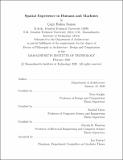Spatial experience in humans and machines
Author(s)
Zaman, C̦ağrı Hakan.
Download1237121644-MIT.pdf (11.00Mb)
Other Contributors
Massachusetts Institute of Technology. Department of Architecture.
Advisor
Terry Knight and Randall Davis.
Terms of use
Metadata
Show full item recordAbstract
Spatial experience is the process by which we locate ourselves within our environment, and understand and interact with it. Understanding spatial experience has been a major endeavor within the social sciences, the arts, and architecture throughout history, giving rise to recent theories of embodied and enacted cognition. Understanding spatial experience has also been a pursuit of computer science. However, despite substantial advances in artificial intelligence and computer vision, there has yet to be a computational model of human spatial experience. What are the computations involved in human spatial experience? Can we develop machines that can describe and represent spatial experience? In this dissertation, I take a step towards developing a computational account of human spatial experience and outline the steps for developing machine spatial experience. Building on the core idea that we humans construct stories to understand the environment and communicate with each other, I argue that spatial experience is a type of story we tell ourselves, driven by what we perceive and how we act within the environment. Through two initial case studies, I investigate the relationships between stories and spatial experience and introduce the anchoring framework --a computational model of constructing stories using emergent spatial, temporal, and visual relationships in perception. I evaluate this framework by performing a visual exploration study and analyzing how people verbally describe environments. Finally, I implement the anchoring framework for creating spatial experiences by machines. I introduce three examples, which demonstrate that machines can solve visuo-spatial problems by constructing stories from visual perception using the anchoring framework. This dissertation contributes to the fields of design, media studies, and artificial intelligence by advancing our understanding of human spatial experience from a story perspective; providing a set of tools and methods for creating and analyzing spatial experiences; and introducing systems that can understand the physical environment and solve spatial problems by constructing stories.
Description
Thesis: Ph. D. in Architecture: Design and Computation, Massachusetts Institute of Technology, Department of Architecture, February, 2019 Cataloged from student-submitted thesis. Includes bibliographical references (pages 215-224).
Date issued
2019Department
Massachusetts Institute of Technology. Department of ArchitecturePublisher
Massachusetts Institute of Technology
Keywords
Architecture.